1. Early Life and Education
Timothy John Berners-Lee was born in London, England, on 8 June 1955. His parents, Mary Lee Woods and Conway Berners-Lee, were both mathematicians and computer scientists who worked on the Ferranti Mark 1, one of the first commercially built computers. They instilled in him an early appreciation for mathematics and problem-solving.
Berners-Lee attended Sheen Mount Primary School, and from 1969 to 1973, he studied at Emanuel School in Wandsworth, London, which was then a direct grant grammar school. As a child, he was a keen trainspotter and developed an interest in electronics by tinkering with a model railway.
From 1973 to 1976, he pursued his higher education at The Queen's College, Oxford, where he earned a first-class Bachelor of Arts degree in physics. During his time at Oxford, he famously built his first computer using a soldering iron, TTL gates, an MC6800 processor, and an old television set he had purchased from a repair shop. He also engaged in "hacking" with friends on university computers, which at one point led to a temporary ban from using the university's computing facilities.
2. Early Career
After graduating from Oxford in 1976, Berners-Lee began his professional career as an engineer at the telecommunications company Plessey in Poole, Dorset. For two years, he worked on distributed transaction systems, message relays, and barcode technology.
In 1978, he moved to D.G. Nash in Ferndown, Dorset, where he contributed to the creation of typesetting software for printers and developed a multitasking operating system. This period provided him with valuable experience in software development and system design. Following his tenure at D.G. Nash, he worked as an independent consultant, further honing his technical skills.
3. Career at CERN and Web Proposal
Berners-Lee's pivotal work began during his time as an independent contractor at the CERN in Geneva, Switzerland, from June to December 1980. While there, he identified a need for a more efficient system to share and update information among the thousands of researchers and participants. He proposed a project based on the concept of hypertext and, to demonstrate its potential, built a prototype system called ENQUIRE. This early system, though never formally published, laid the conceptual groundwork for what would later become the World Wide Web.
After a period working at John Poole's Image Computer Systems, Ltd., in Bournemouth, Dorset, where he was responsible for technical design and gained experience in real-time remote procedure calls and computer networking, Berners-Lee returned to CERN in 1984 as a fellow. He worked on distributed real-time systems for scientific data acquisition and control, including FASTBUS system software and designing a heterogeneous remote procedure call system.
By 1989, CERN had become the largest Internet node in Europe. Recognizing the opportunity to combine hypertext with the burgeoning Internet, Berners-Lee formally proposed a global hypertext project to access information within CERN in March 1989. He envisioned a system that would link information globally, stating, "I just had to take the hypertext idea and connect it to the TCP and DNS ideas and-ta-da!-the World Wide Web." He further elaborated that creating the web was "an act of desperation, because the situation without it was very difficult." With the support of his manager, Mike Sendall, who described his proposals as "vague, but exciting," and the collaboration of Robert Cailliau, Berners-Lee submitted a more detailed proposal, "WorldWideWeb: Proposal for a HyperText Project," in November 1990.

4. Invention of the World Wide Web
Building upon the concepts of the ENQUIRE system, Berners-Lee embarked on the development of the World Wide Web. In December 1990, he successfully constructed the first web browser and editor, which he named WorldWideWeb, running on the NeXTSTEP operating system. Simultaneously, he developed the first web server, known as CERN HTTPd (short for Hypertext Transfer Protocol daemon).
The world's first website, located at `http://info.cern.ch/`, was published on 20 December 1990, becoming accessible to the Internet from the CERN network. This pioneering site provided an explanation of what the World Wide Web was, instructions on how to use a browser, how to set up a web server, and guidance for creating one's own website. It also served as the first web directory, as Berners-Lee maintained a list of other websites. On 6 August 1991, Berners-Lee publicly invited collaboration on the WorldWideWeb project by posting a summary to the alt.hypertext Usenet newsgroup.
A crucial decision that profoundly impacted the web's future was CERN's announcement on 30 April 1993, declaring the World Wide Web technology freely available to anyone, without any fees. This commitment to openness, driven by Berners-Lee's vision, ensured the web's rapid and widespread adoption. In 2016, a panel of eminent scientists, academics, writers, and world leaders ranked the invention of the World Wide Web as the number one cultural moment that shaped the world, acknowledging it as "The fastest growing communications medium of all time, the Internet has changed the shape of modern life forever."
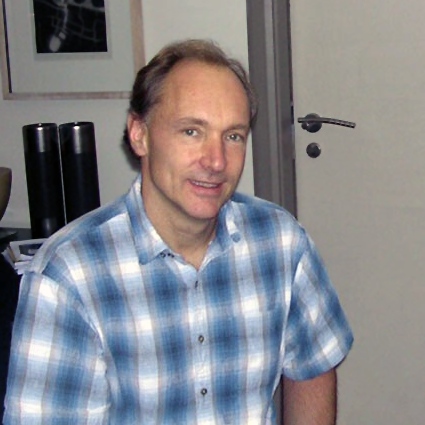
5. Founding and Leadership of the World Wide Web Consortium (W3C)
In 1994, Berners-Lee moved to the Massachusetts Institute of Technology (MIT) and founded the World Wide Web Consortium (W3C). The W3C's mission is to develop and maintain web standards and recommendations, ensuring the web's continued evolution and interoperability.
Berners-Lee's decision to make his invention freely available, without patents or royalties, was fundamental to the W3C's philosophy. The consortium adopted a policy that its standards should be based on royalty-free technology, facilitating easy adoption by anyone globally. As the director of the W3C, Berners-Lee has guided its growth and remained a staunch advocate for open, non-proprietary web technologies, believing that the web's potential can only be maximized through universal access and shared standards.
6. Academic and Research Contributions
Berners-Lee has held significant academic appointments and engaged in extensive research throughout his career. He was a senior researcher and held the 3Com founder's chair at the MIT Computer Science and Artificial Intelligence Laboratory (CSAIL).
In December 2004, he accepted a chair in computer science at the School of Electronics and Computer Science, University of Southampton, where he focused on the Semantic Web. In October 2016, he joined the Department of Computer Science at Oxford University as a professorial research fellow and became a fellow of Christ Church, one of Oxford's constituent colleges. He is also a director of the Web Science Research Initiative (WSRI) and a member of the advisory board of the MIT Center for Collective Intelligence.
7. Semantic Web and Web Science
Berners-Lee's vision for the web extends beyond its current form. He has been a leading proponent of the Semantic Web, a concept he articulated in 2001, which aims to make internet data machine-readable and interconnected, enabling more intelligent and automated web services. His work on the Semantic Web at the University of Southampton has been instrumental in advancing this initiative.
In 2006, he co-founded the Web Science Research Initiative (later the Web Science Trust) to foster a new multidisciplinary field of study dedicated to understanding the World Wide Web. This initiative seeks to analyze the web's social, technical, and economic aspects, offering practical solutions to guide its future use and design. Berners-Lee's efforts in Web Science underscore his commitment to advancing the web's capabilities and ensuring its responsible development.
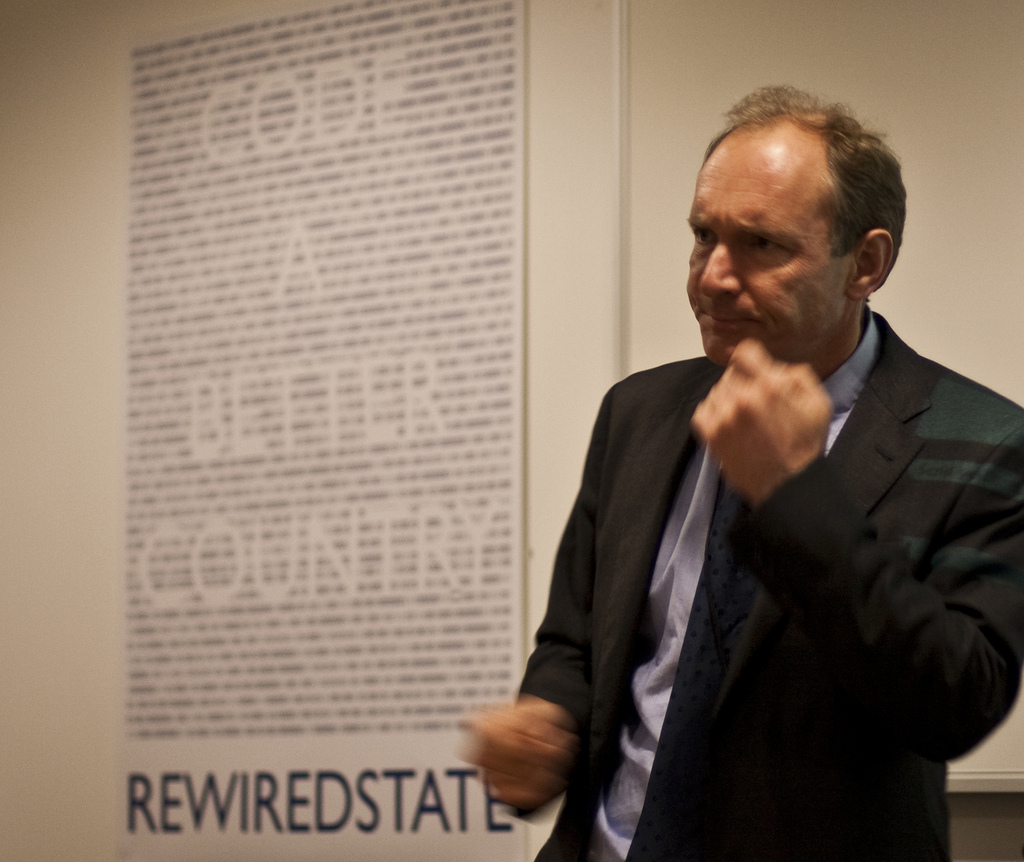
8. Policy Work and Advocacy
Berners-Lee has been a prominent voice in global policy matters, advocating for principles that he believes are crucial for the web's future. In 2010, he collaborated with Nigel Shadbolt to create data.gov.uk, a pioneering initiative to make UK government data openly accessible. He emphasized that "Greater openness, accountability and transparency in Government will give people greater choice and make it easier for individuals to get more directly involved in issues that matter to them." He is also a founder and president of the Open Data Institute in the UK, established in 2012, which promotes open data globally.
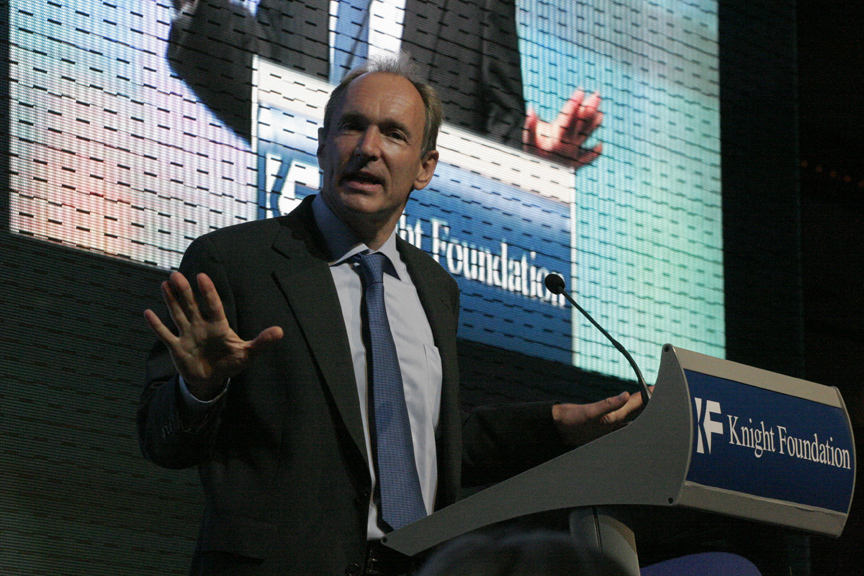
He is a staunch advocate for net neutrality, arguing that Internet Service Providers (ISPs) should provide "connectivity with no strings attached" and should not control or monitor customer browsing activities without explicit consent. He views net neutrality as a fundamental human network right, stating that "Threats to the Internet, such as companies or governments that interfere with or snoop on Internet traffic, compromise basic human network rights." In 2017, he joined other Internet pioneers in urging the US Federal Communications Commission (FCC) to uphold net neutrality.
In October 2013, Berners-Lee began leading the Alliance for Affordable Internet (A4AI), a coalition of public and private organizations including Google, Facebook, Intel, and Microsoft. The A4AI aims to make Internet access more affordable in developing countries, working towards the UN Broadband Commission's target of Internet access costing less than 5% of monthly income.
In November 2019, at the Internet Governance Forum in Berlin, Berners-Lee and the World Wide Web Foundation (WWWF), which he launched in 2009, introduced the Contract for the Web. This initiative calls upon governments, companies, and citizens to commit to nine principles designed to prevent the web's "misuse" and ensure its potential for good is not squandered by those who seek to "exploit, divide and undermine."
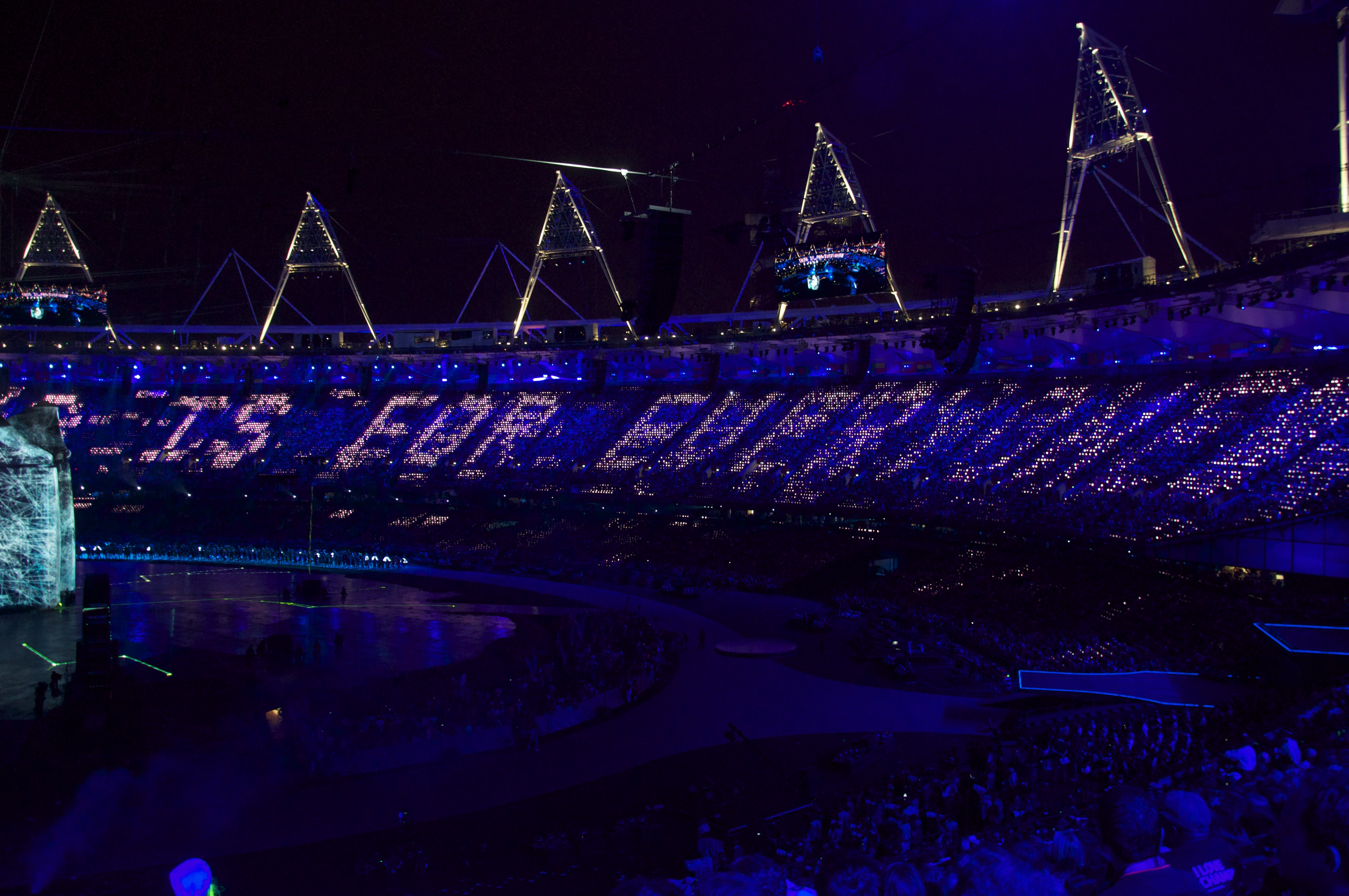
Berners-Lee was also honored during the 2012 Summer Olympics opening ceremony in London, where he appeared working with a vintage NeXT Computer. He famously tweeted "This is for everyone," a message that was instantly displayed in LED lights attached to the chairs of the 80,000 audience members, symbolizing the web's universal accessibility.
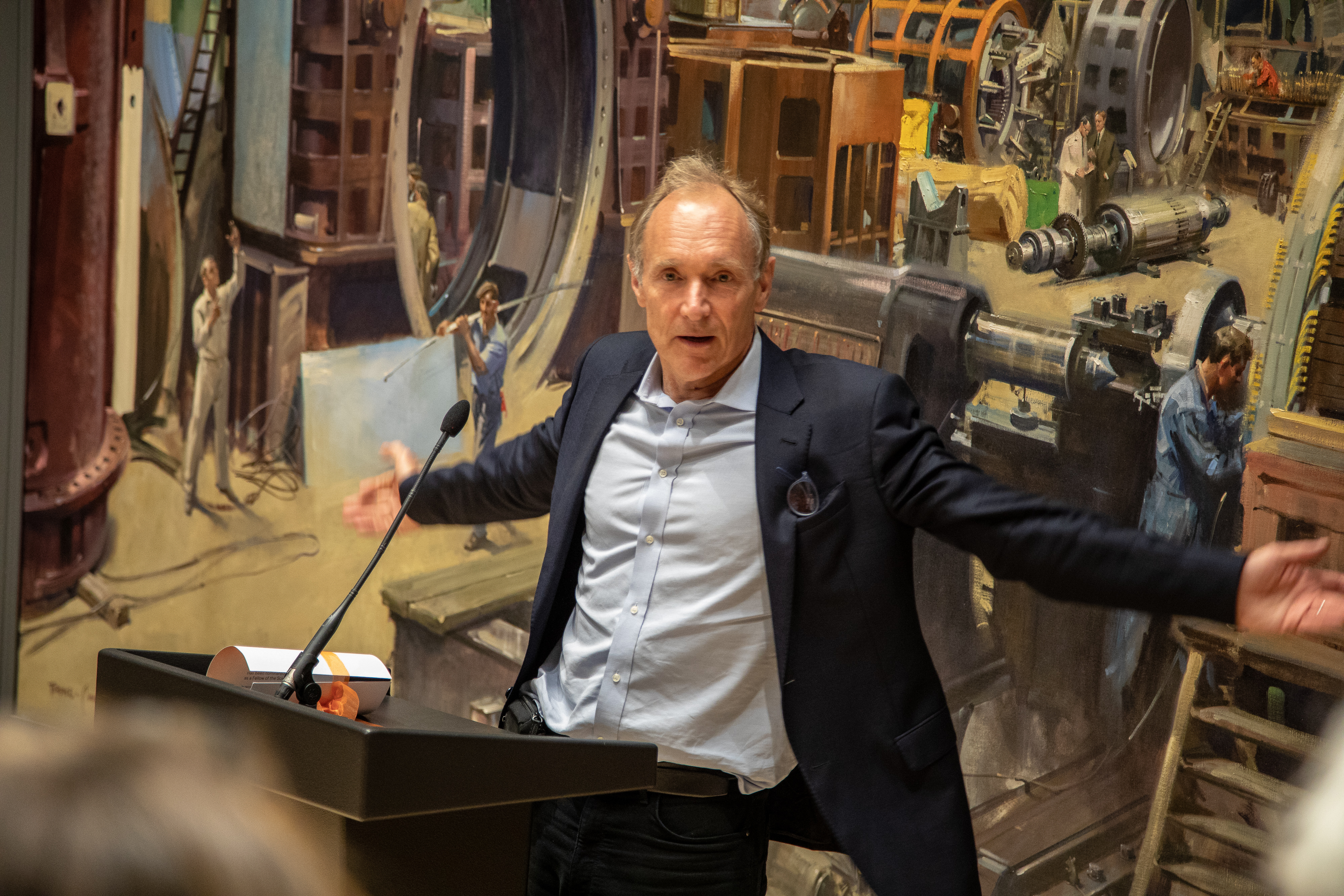
9. Later Projects and Initiatives
Berners-Lee's recent work continues to focus on decentralizing the web and giving users more control over their data. He leads the Solid project, a joint initiative with the Qatar Computing Research Institute, which aims to radically change how web applications function, leading to genuine data ownership and enhanced privacy.
In September 2018, he announced the launch of Inrupt, an open-source startup designed to build a commercial ecosystem around the Solid project. Inrupt's goal is to empower users to choose where their personal data is stored, who can access it, and which applications are permitted to view specific data elements.
He has also participated in the development and promotion of the Curl programming language and has served as an advisor to social network MeWe. In a notable event in June 2021, the web's original source code was auctioned by Sotheby's in London as a non-fungible token (NFT). The NFT sold for 5.43 M USD, with the proceeds reportedly funding initiatives by Berners-Lee and his wife.
10. Philosophy and Ideology
Sir Tim Berners-Lee's philosophy is deeply rooted in the principles of openness, accessibility, and user empowerment. He believes the web should be a universal medium, free from proprietary control and accessible to everyone, regardless of their location or economic status. His decision to make the web's foundational technologies royalty-free exemplifies his commitment to this vision, ensuring that the web remains a public good rather than a private commodity.
He is a staunch advocate for user privacy and control over personal data, viewing the current centralized model of the web as problematic. His work on the Solid project and Inrupt startup directly addresses these concerns, aiming to decentralize data storage and empower individuals to manage their own information. Berners-Lee has consistently highlighted the social impact of technology, emphasizing the web's potential as a tool for positive change while also warning against its misuse for exploitation, division, and undermining.
His stance on certain technical issues has occasionally drawn criticism. For instance, in 2017, he supported the Encrypted Media Extensions (EME) proposal, which has digital rights management (DRM) implications. While he reasoned that DRM was inevitable and EME offered certain virtues, his position was opposed by organizations like the Electronic Frontier Foundation (EFF), the anti-DRM campaign Defective by Design, and the Free Software Foundation. Critics argued that this stance went against the web's open philosophy and could force users to rely on specific web browsers to view DRM-protected content. Despite the opposition, the EME specification became a formal W3C recommendation in September 2017.
Berners-Lee's overall ideology reflects a strong commitment to digital rights and equitable access, constantly striving to ensure the web fulfills its promise as a transformative force for humanity. He even lightheartedly apologized for the "unnecessary" initial double slashes ("//") in web addresses, acknowledging it seemed like a good idea at the time.
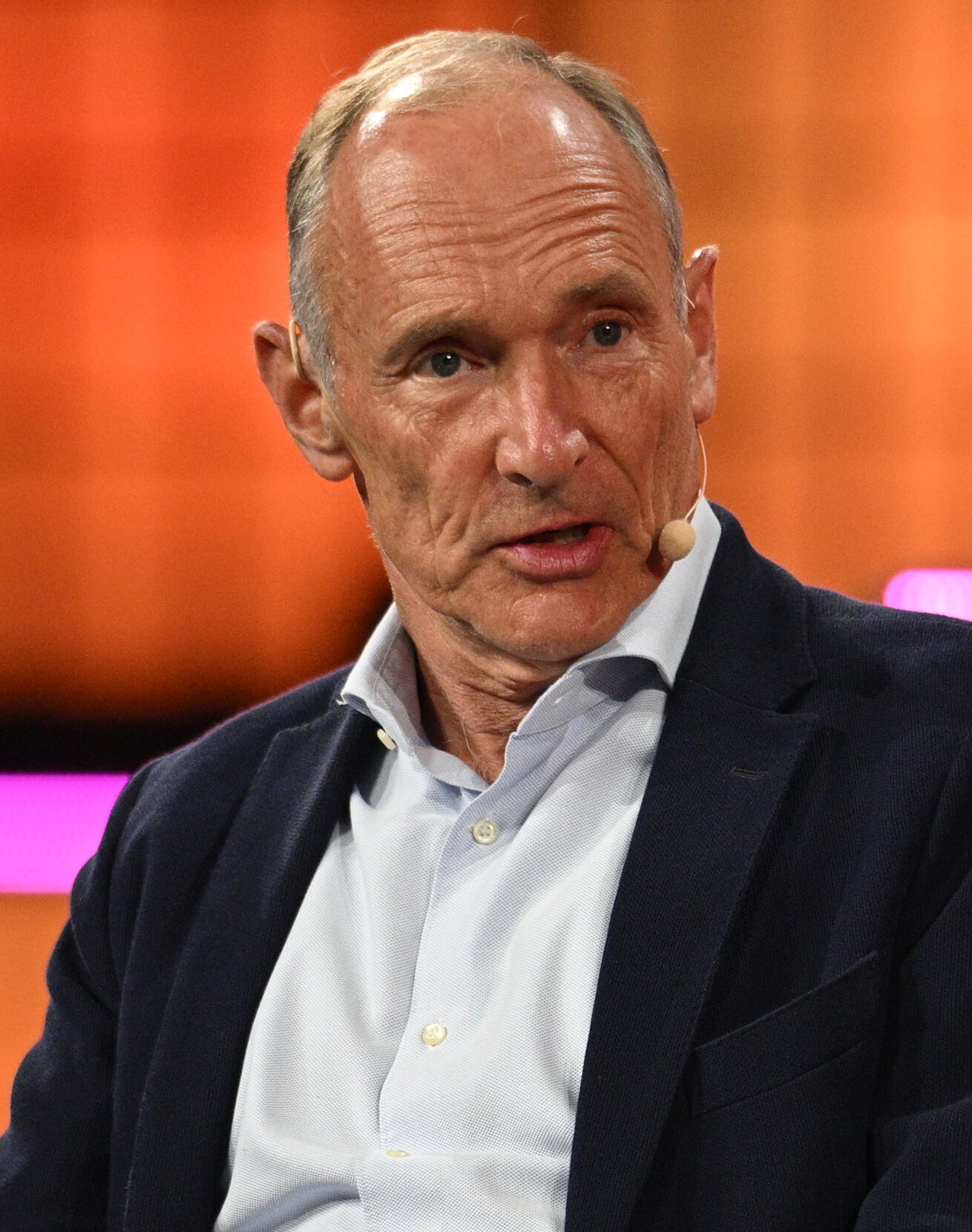
11. Personal Life
Berners-Lee prefers to keep his work and personal life separate. He married Nancy Carlson, an American computer programmer, in 1990. They had two children together before divorcing in 2011.
In 2014, he married Rosemary Leith at the Chapel Royal, St. James's Palace in London. Leith is a Canadian Internet and banking entrepreneur. She is a founding director of Berners-Lee's World Wide Web Foundation and a member of the Berkman Center at Harvard University. She has also served as Chair of the World Economic Forum's Global Agenda Council on the Future of Internet Security and is a board member of YouGov. The couple also collaborates on venture capital initiatives that support artificial intelligence companies. Berners-Lee also has three step-children from Rosemary Leith's previous marriage.
11.1. Religious Beliefs
Berners-Lee was raised as an Anglican but turned away from religion in his youth. However, after becoming a parent, he revisited his spiritual beliefs and became a Unitarian Universalist (UU). He and his wife sought a spiritual framework for their children, and after consulting a minister and visiting a Unitarian Universalist church in Boston, they embraced the faith. He is an active member of his UU church, valuing its tolerant and liberal approach to belief. He has expressed respect for other religions, stating, "I believe that the greater part of the philosophy of life associated with many religions is much more sound than the dogma that comes along with it." He has also stated, "Not in the sense of most people, I'm atheist and Unitarian Universalist."
12. Awards and Honours
Sir Tim Berners-Lee has received numerous awards and honors for his pioneering work and significant contributions to the World Wide Web. He holds the Order of Merit (OM), is a Knight Commander of the Order of the British Empire (KBE), a Fellow of the Royal Society (FRS), a Royal Designer for Industry (RDI), a Fellow of the Royal Society of Arts (FRSA), a Distinguished Fellow of the British Computer Society (DFBCS), and a Fellow of the Royal Academy of Engineering (FREng).
- In 1995, he received the ACM Software System Award and the Ars Electronica Award.
- He was awarded an honorary degree by the University of Southampton in 1996.
- In 1997, he was appointed an Officer of the Order of the British Empire (OBE).
- He received the MacArthur Fellowship and the Eduard Rhein Foundation Technology Award in 1998.
- In 1999, Time magazine included him in its list of the "100 Most Important People of the 20th Century", stating, "He wove the World Wide Web and created a mass medium for the 21st century. The World Wide Web is Berners-Lee's alone. He designed it. He loosed it on the world. And he more than anyone else has fought to keep it open, nonproprietary and free."
- He was elected a Fellow of the Royal Society (FRS) in 2001 and received honorary degrees from Columbia University and Oxford University.
- In 2002, he was a recipient of the prestigious Japan Prize and the Prince of Asturias Award for Scientific and Technical Research. That same year, he was also included in the BBC's list of "100 Greatest Britons."
- The Computer History Museum honored him with a Fellow Award in 2003 for his crucial contributions to the development of the World Wide Web.
- In 2004, he became the first recipient of the Millennium Technology Prize. On 16 July 2004, he was knighted by Queen Elizabeth II as a Knight Commander of the Order of the British Empire (KBE) "for services to the global development of the Internet." He also received an honorary doctorate in science from Lancaster University.
- He was named "Greatest Briton 2004" in January 2005.
- In 2007, he was ranked first, tied with Albert Hofmann, in a The Daily Telegraph poll of "Top 100 living geniuses." He also received the Charles Stark Draper Prize and, on 13 June 2007, was appointed to the Order of Merit (OM), a rare honor bestowed personally by the Sovereign and limited to 24 living members.
- He received the Webby Award for Lifetime Achievement in 2009 and was elected as a Foreign Associate of the National Academy of Sciences in April 2009. He also received an honorary doctorate from Vrije Universiteit Amsterdam.
- In 2012, Berners-Lee was among the British cultural icons chosen by artist Sir Peter Blake to appear in a new version of his famous Sgt. Pepper's Lonely Hearts Club Band album cover, celebrating British cultural figures for Blake's 80th birthday.
- He was awarded the inaugural Queen Elizabeth Prize for Engineering in 2013.
- In 2016, he received the Turing Award from the Association for Computing Machinery (ACM) "for inventing the World Wide Web, the first web browser, and the fundamental protocols and algorithms allowing the Web to scale."
- He was awarded an honorary doctorate from Keio University in 2017.
- In 2022, he was awarded the Seoul Peace Prize.
13. Legacy and Impact
Sir Tim Berners-Lee's invention of the World Wide Web has had a profound and lasting impact on global society, technology, and culture, fundamentally reshaping how information is accessed, shared, and utilized.
13.1. Positive Impact
The World Wide Web, along with its foundational components like HTML, URL, and HTTP, revolutionized information accessibility, making a vast repository of knowledge available to billions worldwide. This unprecedented access to information has democratized education, facilitated global communication, and fostered countless innovations across various sectors. The web has become the "fastest growing communications medium of all time," transforming modern life by enabling instant connectivity across the globe. Berners-Lee's commitment to an open, royalty-free web ensured its rapid and widespread adoption, allowing it to become a universal platform for creativity, commerce, and social interaction. His advocacy for principles like net neutrality and open data continues to shape policies aimed at preserving the web's inclusive and equitable nature, ensuring its benefits extend to all of humanity.
13.2. Criticism and Controversy
While Berners-Lee's contributions are overwhelmingly celebrated, some of his decisions and views have drawn criticism. A notable instance is his stance on Encrypted Media Extensions (EME) and digital rights management (DRM). Initially, he remained neutral on the EME proposal, but in March 2017, he publicly supported it, reasoning that DRM was inevitable and EME offered a pragmatic solution. As W3C director, he approved the finalized specification in July 2017. This decision was met with strong opposition from organizations such as the Electronic Frontier Foundation (EFF), the anti-DRM campaign Defective by Design, and the Free Software Foundation. Critics argued that incorporating DRM into web standards contradicted the web's core philosophy of openness and could lead to a fragmented web where users might be forced to use specific web browsers to access certain content. Despite a formal appeal by the EFF, the EME specification became a formal W3C recommendation in September 2017. This episode highlighted the tension between commercial interests and the web's founding principles of openness and freedom.
14. Books and Publications
Sir Tim Berners-Lee has authored and co-authored several significant works, primarily focusing on the World Wide Web and its future.
- Weaving the Web: The Original Design and Ultimate Destiny of the World Wide Web by Its Inventor (1999), co-authored with Mark Fischetti. This book chronicles his vision for the web, its origins, and his hopes for its future development.
- Spinning the Semantic Web: Bringing the World Wide Web to Its Full Potential (2005), where he contributed a foreword, outlining his vision for a more intelligent, machine-readable web.
- A Framework for Web Science (2006), co-authored with Wendy Hall and James A. Hendler, which lays out the foundations for the academic field of Web Science.